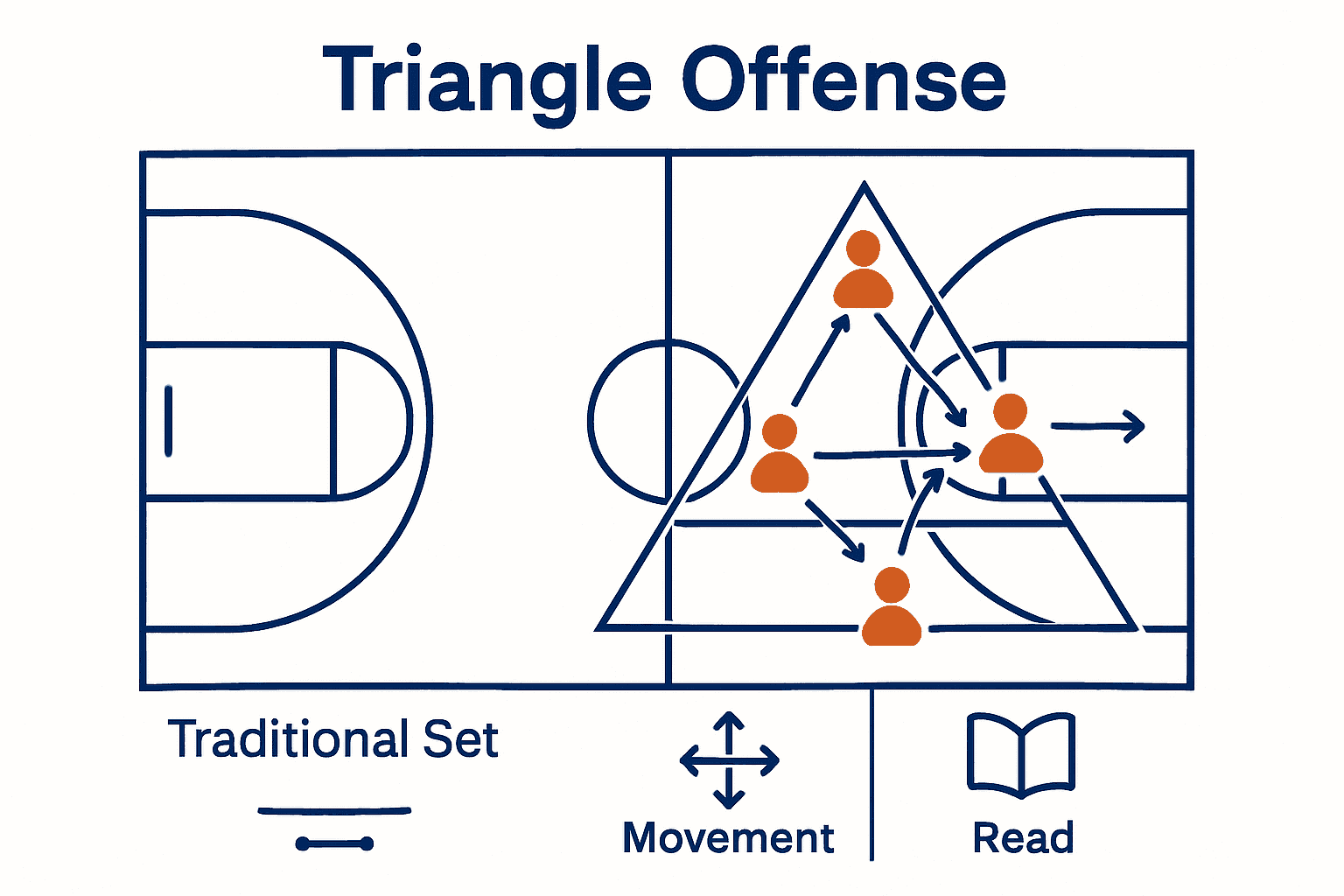Teams that use the triangle offense have lifted dozens of championship banners, and NBA Hall of Fame coach Phil Jackson won 11 titles with it. This approach changes how players see the court and work together, turning complicated defensive setups into clear scoring chances. By breaking down movement and spacing fundamentals, coaches and players can use these core principles to build smarter, more connected offenses that keep defenses guessing.
Table of Contents
- Triangle Offense Defined And Core Principles
- Key Actions And Player Responsibilities
- Setting Up And Teaching The Triangle
- Advantages And Suitability For Teams
- Common Challenges And How To Avoid Them
Key Takeaways
| Point | Details |
|---|---|
| Fundamental Principles | The triangle offense focuses on positional flexibility, constant movement, and spacing awareness to create scoring opportunities and enhance dynamic play. |
| Player Responsibilities | Each player has specific roles, emphasizing teamwork and effective communication to exploit defensive weaknesses. |
| Implementation Challenges | Successful execution requires patience, strong basketball IQ, and consistent practice to overcome complexity in skill and timing. |
| Suitability for Teams | Best suited for teams with versatile players who prioritize collaboration over individual statistics, enhancing overall offensive performance. |
Triangle Offense Defined and Core Principles
The triangle offense represents a sophisticated basketball strategy designed to maximize team offensive potential through intelligent player positioning and movement. According to Masterclass, this approach creates three strategic triangles on the basketball court, enabling multiple scoring opportunities and dynamic offensive flexibility.
At its core, the triangle offense fundamentally transforms traditional basketball positioning. Basketball HQ emphasizes that the strategy prioritizes three critical elements: precise spacing, rapid ball movement, and continuous player motion without possession. These principles allow teams to systematically adapt to different defensive configurations and exploit potential mismatches.

The key principles of the triangle offense include:
- Positional Flexibility: Players maintain strategic court positions that create multiple passing and scoring options
- Constant Movement: Continuous player motion disrupts defensive strategies
- Multiple Read Options: Offensive players can react dynamically based on defensive positioning
- Spacing Awareness: Maintaining optimal distance between players to create passing and scoring lanes
Understanding these core principles requires coaches and players to reimagine traditional offensive approaches.
 The triangle offense demands high basketball IQ, precise timing, and a collective commitment to team-oriented play. While complex to master, it offers a nuanced approach to offensive strategy that can dramatically enhance team performance.
The triangle offense demands high basketball IQ, precise timing, and a collective commitment to team-oriented play. While complex to master, it offers a nuanced approach to offensive strategy that can dramatically enhance team performance.
For a deeper exploration of evolving offensive strategies, check out our basketball offensive concepts guide.
Key Actions and Player Responsibilities
In the triangle offense, each player assumes a critical role with specific responsibilities that contribute to the overall team strategy. JES Basketball highlights the fundamental positioning, where the center and forward occupy post positions, while guards and small forwards interchangeably manage perimeter roles. This dynamic positioning begins with the point guard initiating offense through strategic passing or controlled dribbling.
Ball Movement Dynamics are paramount in this offensive scheme. Basketball HQ emphasizes that success hinges on rapid decision-making and prioritizing passing over individual dribbling. Players must continuously read defensive configurations and make split-second choices that create scoring opportunities.
Specific player responsibilities include:
Here’s a summary of main player roles and their responsibilities in the triangle offense:
| Player Position | Primary Responsibilities | Key Skills Required |
|---|---|---|
| Point Guard | Initiate offense Entry passes Create lanes |
Decision-making Vision |
| Wing Players | Maintain spacing Quick cuts Catch-and-shoot |
Shooting Off-ball movement |
| Post Players | Set screens Create passing angles Score inside |
Footwork Physical presence |
| Small Forward | Flexibility Exploit mismatches |
Versatility Spatial awareness |
- Point Guard: Initiate offensive sequences, make initial entry passes, create passing lanes
- Wing Players: Maintain spacing, execute quick cuts, be ready for catch-and-shoot opportunities
- Post Players: Set screens, create passing angles, be prepared for interior scoring
- Small Forward: Provide positional flexibility, exploit defensive mismatches
Successful implementation requires players to develop exceptional court awareness and basketball intelligence. Each team member must understand not just their individual role, but how their movements interconnect to create a fluid, unpredictable offensive system.
For coaches looking to develop comprehensive team strategies, our basketball playbook creation guide offers additional insights into building adaptive offensive systems.
Setting Up and Teaching the Triangle
Implementing the triangle offense requires a systematic approach to player development and skill building. IRP Research emphasizes that mastering this offensive strategy demands a comprehensive understanding of fundamental basketball skills, including precise spacing, strategic ball movement, and advanced decision-making capabilities.
The teaching process begins with breaking down complex movements into manageable skill components. Basket Research recommends a progressive learning approach that develops skills from youth through senior levels, focusing on critical technical elements such as:
- Footwork Fundamentals: Precise positioning and movement patterns
- Passing Techniques: Quick, accurate ball distribution
- Shooting Mechanics: Creating and converting open shot opportunities
- Spatial Awareness: Understanding court positioning and movement
Coaches must design targeted drills that isolate and reinforce these specific skills. This means creating practice scenarios that simulate triangle offense situations, allowing players to develop muscle memory and intuitive understanding of the offensive system. Players need to learn not just individual skills, but how those skills interconnect within the larger offensive framework.
Progressively increasing complexity is key to successful implementation. Start with basic positioning and passing drills, then gradually introduce more sophisticated movement patterns and decision-making scenarios. This approach helps players build confidence and understanding without overwhelming them with the entire system at once.
For coaches seeking comprehensive player development strategies, our guide on player development tips provides additional insights into building well-rounded basketball skills.
Advantages and Suitability for Teams
Strategic team composition plays a crucial role in successfully implementing the triangle offense. Masterclass highlights that this offensive strategy offers remarkable flexibility, effectively adapting to both man-to-man and zone defensive configurations. This adaptability makes the triangle offense an excellent choice for teams seeking to create consistent, high-percentage scoring opportunities.
Basketball HQ emphasizes the offense’s unique advantage in exploiting defensive mismatches through its sophisticated spacing and fluid ball movement. The system is particularly well-suited for teams with the following characteristics:
- High Basketball IQ: Players who understand complex movement patterns
- Versatile Skill Sets: Athletes capable of multiple offensive roles
- Strong Passing Skills: Team members who can read and react quickly
- Collaborative Mindset: Players committed to team-oriented play
The triangle offense demands more than individual talent. It requires a collective commitment to understanding complex spatial relationships and making split-second decisions. Teams with players who prioritize team success over individual statistics will find this system most effective. Coaches must invest significant time in building a shared mental framework that allows players to anticipate and respond to defensive shifts.
While not universally applicable, the triangle offense can transform teams with the right blend of skills, basketball intelligence, and collaborative spirit. Success depends on comprehensive player development and a patient, systematic approach to implementing the system.
Coaches interested in understanding team dynamics more deeply might find insights in our guide on handling team conflict to support the collaborative mindset needed for this offensive strategy.
Common Challenges and How to Avoid Them
Implementing the triangle offense presents significant learning challenges for teams and coaches. French Research indicates that full player adaptation can require an entire season, highlighting the complexity of this offensive strategy. Coaches must approach implementation with patience and a structured, progressive learning approach.
German Research emphasizes the critical requirement of player versatility and game intelligence, which often becomes the primary obstacle in successful triangle offense execution. The most common challenges include:
- Skill Complexity: Demanding precise off-ball movement and spatial awareness
- Mental Adaptation: Requiring players to think collectively rather than individually
- Timing Synchronization: Needing split-second decision-making and coordination
- Player Ego Management: Prioritizing team success over personal statistics
To mitigate these challenges, coaches should implement a gradual, step-by-step learning process. Begin with fundamental positioning drills, then progressively introduce more complex movement patterns. Players need consistent repetition and positive reinforcement to develop the intuitive understanding necessary for seamless triangle offense execution.
Successful implementation demands ongoing communication and a commitment to collective skill development. Coaches must create an environment that values basketball intelligence, encourages continuous learning, and supports players through the inevitable frustrations of mastering this sophisticated offensive system.
For coaches looking to build stronger team dynamics that support complex strategies, our guide on team conflict resolution offers additional insights into creating a collaborative team environment.
Master the Triangle Offense with Expert Coaching Resources
The triangle offense offers a powerful path to transforming your team’s offensive game but mastering its complexity requires precision, patience, and smart practice planning. If you are struggling with teaching precise spacing, timing synchronization, or managing the mental adaptation your players need to execute split-second decisions confidently this article will resonate with your coaching challenges. At Hoop Mentality we understand how demanding it is to implement a system that relies so much on basketball IQ and team collaboration.

Unlock your team’s full potential with professional playbooks, progressive drills, and clear practice plans crafted to build the skills outlined in this guide. Whether you want to improve your players’ spatial awareness or develop their passing and movement through real coached strategies Hoop Mentality is your go-to resource. Take control of your season and start turning complexity into clarity by visiting Hoop Mentality. Explore our basketball playbook creation guide and the player development tips to make the triangle offense work for your team now.
Frequently Asked Questions
What is the triangle offense in basketball?
The triangle offense is a basketball strategy that creates three strategic triangles on the court, enabling multiple scoring opportunities through intelligent player positioning and movement.
What are the core principles of the triangle offense?
The core principles include positional flexibility, constant movement, multiple read options, and spacing awareness, which allow teams to adapt to defenses and exploit mismatches effectively.
How do players execute their roles within the triangle offense?
Players have specific roles: point guards initiate offenses, wing players maintain spacing and take shots, post players create angles and score inside, and small forwards provide flexibility to exploit mismatches.
What are some common challenges when implementing the triangle offense?
Challenges include the complexity of player movements, the need for collective thinking, timing synchronization, and managing player egos in a team-oriented system.

